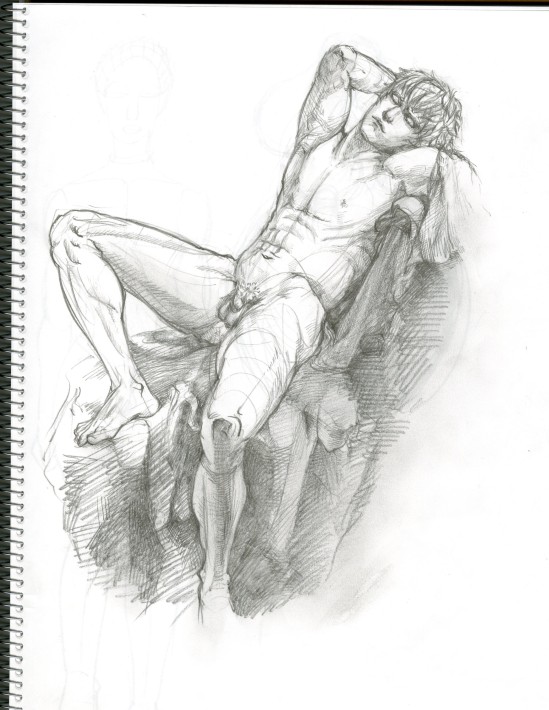Basics of the Figures in Each of the 4 Periods of Greek Art
Geometric Period

Greek Geometric, Bronze horse, 8th century B.C., H.: 6 15/16 x 5 1/4 x 1 3/8 in. (17.6 x 13.3 x 3.5 cm), The Metropolitan Museum of Art
The geometric shapes are simply put together according to the horse physical structure. We can see basic anatomy here, but not following the scientific way. Their gestures are not indicated. They are rigid. In general, it is the form in people’s mind, not in reality. Hence we can define it as a Greek sculpture from the Geometric Period. (I think it is formed of geometric shapes at their most elegance. )
Archaic Period

Greek Archaic, Terracotta psykter (vase for cooling wine), ca. 520–510 B.C., H. 11 7/8 in. (30.20 cm),The Metropolitan Museum of Art
It is a red-figure vase for cooling wine. The figures are all strictly of a side view. Although their poses are stiff, we see very stylized heads and bodies. They are simplified and flat, but we can see there is depth in the content. Hence we know it is a Greek sculpture from the Archaic Period.
Classical Period

Greek Classical, Marble statue of Hermes ( Roman Copy of work attributed to Polykleitos), 1st or 2nd century A.D., 71 1/4 x 29 1/2 x 23 1/2 in. (181 x 74.9 x 59.7 cm),The Metropolitan Museum of Art
It is a figure in contrapposto, a counter-posed figure standing with most of his weight on one foot, so that his center of the body twists off a bit to give a more relaxed feeling. He looks away into somewhere down his left from the front viewer. The figure from this period of the time starts to look like he is conscious about something. Despite of his dynamic pose, his face looks calm and his whole mood seems to be at rest. Although his center of the body is off set, we can still see his perfect balance of the body, which reflects the order of the universe. Hence we know it is a Greek sculpture from the Classical Period.
Hellenistic Period

Greek Hellenistic, Sleeping satyr (Barberini Faun), ca. 230-200 BCE., approx. 7’ 1” high, Glyptothek, Munich.
It is a dramatic Gaul figure. Just a sleeping man, why does he sleep like suffering from the craziest emotions? I love it for its erotic, wild expression. I can feel the tension and his movement even by seeing the vivid image. This is the charm of the Hellenistic Period Greek sculpture.
Greek Info-graph I Found Online:

Greek God Info-graph I found online
Greek Sculpture Formal Break-down

Sleeping satyr (Barberini Faun), from Rome, Italy, ca. 230-200 BCE. Marble, approx. 7’ 1” high. Glyptothek, Munich.
Lines are planar edges created by light and structure of this figure sculpture. We mainly see a big inverted “Y” formed by his upper body and two separate legs. His widely spread legs focus viewers’ attention on his genital. His arms and neck join at the point of his head, which draw viewers’ attention to his facial expression.
Shapes and values work together to generate the organic rhythm of this sculpture. Created by higher density of shapes and values at the areas closer to his joints, his muscle tension keeps the vigor in a marble sculpture. He is rendered with realistic definition and form.
In spite of being made of white marble, multiple sources of light cast a strong contrast between the texture of his skin and the items beneath his body (rock, cloth). The roughness of the rock and cloth makes his skin look even smoother. Noted that he used to be painted with bright obnoxious colors.
The dimension of the sculpture is made of about life size, which is quite realistic, making the figure more vivid by first impression.
The direction in which his head faces is left blank in space. It gives us a chance to imagine what he is dreaming and leaves us a place to rest our eyes traveling along from his face, right before reaching his opening legs. Also, the negative space made by the sculpture adds depth to it.
Two Sketch Interpretations of Mine
A
Proportion Mapping:
Conclusion: They are almost of the same proportion, except for the lower arm, probably for the samurai on the left is Asian. For Sakata Gintoki, as a fictional idol, his body might be designed intentionally according to the ideal proportion.
Interpretation:

Sleeping satyr (Barberini Faun), from Rome, Italy, ca. 230-200 BCE. Marble, approx. 7’ 1” high. Glyptothek, Munich.
B
Proportion Mapping:
Conclusion: They are not of the same proportion. The Kouros Figure has anatomy but very unnatural. He has longer upper body and head, which indicates the viewer that he has a strong healthy wide shoulder and chest. To do a sketch of my figure in this style and proportion is not time consuming. But the result is not easy to identify who he is according to the main stream aesthetic standards.
Interpretation:





